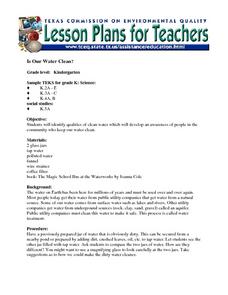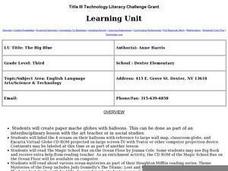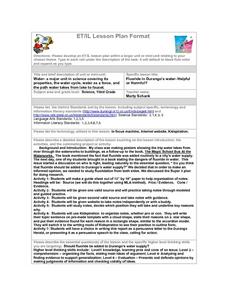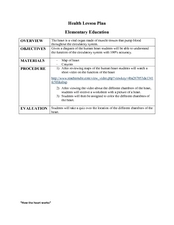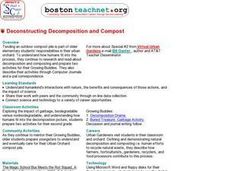Curated OER
Is Our Water Clean?
Students identify qualities of clean water and develop an awareness of people in the community who keep our water clean.
Curated OER
My Happy Habitat
Students observe and discuss the Idaho state quarter to begin an activity in which they define and draw different types of habitats. They discuss the habitats that the migrating Peregrine falcon, which appears on the Idaho quarter,...
Curated OER
Rate of Decomposition
Learners experiment with the decomposition rate of garbage. They discover that environments are fragile and need to be protected and resources are not always used wisely. They then think about their own environment and then about the...
Curated OER
Evaporation in the Water Cycle
Students study the stages of the water cycle and evaporation. For this water cycle lesson, students read Water Cycles and color a diagram of the water cycle. Students review related terms and sing a song about the Water Cycle. Students...
Curated OER
Building a Scale Model
Third graders create a model of the solar system. In this solar system lesson, 3rd graders create a scale model of the solar system. Working in pairs students solve mathematical problems to correctly measure the distance each planet is...
Curated OER
I See a Rainbow
Students identify the different colors in a rainbow. They experiment with dropping food coloring into a water and then making ice cubes. They discuss what happens to the water in the freezer
Curated OER
Green Apples
Third graders brainstorm the effects of light on the growth of plants. In groups, they participate in various activities in which they grow alfalfa sprouts and lima beans. They complete a worksheet on how the varying amount of light...
Curated OER
WEAVING TECHNOLOGY INTO THEMATIC UNITS
Fourth graders explore the planets by researching and writing a report about one of the nine planets.
Curated OER
The Big Blue
Third graders create paper mache globes with balloons. They label the 4 oceans on their balloons with reference to large wall map, classroom globe, and Encarta Virtual Globe CD-ROM projected on large screen TV with Tvator or other...
Curated OER
Animals Galore
Third graders use structural characteristics to sort and classify animals into groups.
Curated OER
The Path of Water
This project is designed so students can learn about the sources of water, the path it takes to get to homes and businesses, and the ways we use water. Students will begin by expanding their awareness of the hydrosphere as they research...
Curated OER
Fluoride in Durango's Water-Helpful or Harmful?
Third graders complete several activities in their quest to find out about the addition of fluoride to city water. First, they create a guide sheet to help organize notes. The next two steps involve taking notes through guided practice....
Curated OER
Investigation 7 - Rubbing Objects Together
Third graders investigate rubbing two objects together to produce heat.
Curated OER
Circulatory System,
Fourth graders study the components and physiology of the human circulatory system.
Curated OER
The Path of Water
Third graders discuss the sources of water, the path it takes to get to homes and businesses, and the ways we use water. Students begin by expanding their awareness of the hydrosphere as they research the water cycle, the sources of our...
Curated OER
Is It Hot in the Light?
Third graders make observations about the temperature of items in direct sunlight. In groups, they discuss why asphalt, brick and cement are warmer than items surrounding them. To end the lesson, they examine how heat transfers energy...
Curated OER
Flower Power
Young scholars investigate and explain the basic needs and life processes of plants. Key concepts include: living things change as they grow and need food, water, and air to survive. The reverse of the Kansas quarter serves as inspiration.
Curated OER
Understanding the Layers of the Earth
Fourth graders explore the three layers of the Earth describing the composition, thickness, and temperature of each layer. Layers are compared and contrasted and data unearthed placed into graphic organizers.
Curated OER
Deconstructing, Decomposition and Compost
Students create and tend to an outdoor compost pile. They research about decomposition and composting. They create two activities for their peers to complete.
Curated OER
Polar Bear Adaptations
Students explore the adaptations that are made by polar bears. They discuss the color of polar bears as well as the dominant color that is found in the arctic. Students create a polar bear puppet.
Curated OER
Insect Communication and Harmful Insects
Seventh graders use children's literature in order to create an interesting context for the lesson. The concept of insect communication is investigated in order for students to form educated hypothesis guesses.
Curated OER
Lend Me Your Ear
Students engage in a lesson to investigate some of the properties of sound. They create sounds and listen to the vibrations that are made while listing all the sounds that are heard. This is done while the eyes are closed to strengthen...
Scholastic
Scholastic:magic School Bus Themes Index
Magic School Bus cross referenced by themes to provide quick access to many activities and references.


